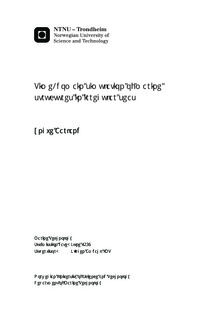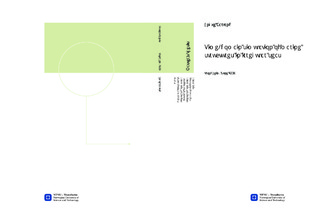| dc.description.abstract | For dynamically sensitive marine structures or marine structures subjected to large displacements the extreme response is often determined on the basis of short term time domain simulation of extreme sea states using the environmental contour line method.
A challenge with time-domain analysis is the representation of the sea spectrum. For linear analysis and small displacements is common to use fast Fourier transform (FFT) of the sea spectrum. In order to avoid repetition of the wave history several thousand of uniformly spaced wave components may be needed. For nonlinear time domain simulations the computational requirements of FFT will become prohibitive.
An alternative to FFT is to use a few wave components based on equal area principle(EAP). This implies that emphasis is placed on the energy rich parts of the wave spectrum. The accuracy of this method must be demonstrated. Using the computer program USFOS it was shown in a previous master thesis work that this method is quite good for floating structures with eigenperiods far away from the energy rich periods of the wave spectrum, but less accurate for structures with eigenperiods in the range of 4-5 seconds. The results depend also on whether the wave forces are mass dominated or drag dominated. It has been suggested that the accuracy may be improved by increasing the subdivision of the wave spectrum in the vicinity of the structure eigenperiod(s).
In USFOS the built-in algorithm for realisation of irregular seas states is based upon linear wave theory and extrapolation of wave kinematics to the instantaneous sea surface (Wheeler stretching). Improved accuracy is obtained by using 2nd order wave theory for surface elevation Wheeler stretching of linear wave kinematics to the surface, and the user may specify the frequency components of the discretised wave spectrum in the input. Most correct is to base wave kinematics completely on 2nd order theory. In USFOS pre-calculated wave kinematics may be represented on a 3D grid and interpolation to actual structure coordinates. It is of interest to compare these methods with respect to extreme response for dynamically sensitive structures.
This thesis investigates the adequacy of using the EAP method, and FFT with increased randomization of wave component frequency (FFTrf and FFTrfa), for realization of the sea spectrum. Additionally, wave kinematics are pre-calculated and given as input for USFOS response analysis. The adequacy of the methods are investigated through dynamic response analysis of the SWAY tower.
A standard FFT realization of the spectrum, with 1000 wave components, have been used to perform a dynamic response analysis in the time domain. This analysis is considered to be a correct solution, and is used as basis for comparing the three other methods.
Analyses have been performed with EAP, FFTrf and FFTrfa methods, using 75,100 and 200 components in separate analyses. The FFTrf and FFTrfa are used to perform additional analyses using 1000 components to further confirm the methods applicability. All analyses have been performed 20 times over using different seeds/phase angles/random parameters for FFT and EAP simulations, and unique wave data input for all FFTrf and FFTrfa analyses. The pre-calculated wave kinematics are based on the use of the FFTrfa method, using 200 components to realize the spectrum.
The wave spectrum used for calculation of wave components and wave kinematics is the JONSWAP spectrum, with parameters: significant wave height Hs=16.4, peak period Tp=17, ad gamma parameter=3.3.
The surface elevation process has been evaluated statistically, and maximums from several result variables have been collected and evaluated. The main focus has been on the goodness of the surface elevation process, and the structural responses.
All simulations are carried out for 1500 seconds, with first 500 seconds not being recorded to the result files. This is done to eliminate any transient response in the beginning of each simulation.
All methods investigated show satisfying results regarding the surface elevation process. The accuracy of the wave profile statistics for the methods when 75 components are used is a little poorer than for simulations based on 100. Best results for the time histories are found for 200 components.
The dynamic responses obtained from simulations using the different methods are also investigated thoroughly. The EAP over predicts the responses for simulations with 75 components, while the the FFTrf and FFTrfa underestimates the responses using 75 components. The best results using the simplified methods of spectrum realization is obtained using the FFTrfa method with 200 components. Both surface elevation process, and load histories resembles the results of the standard FFT method almost identically. | |

